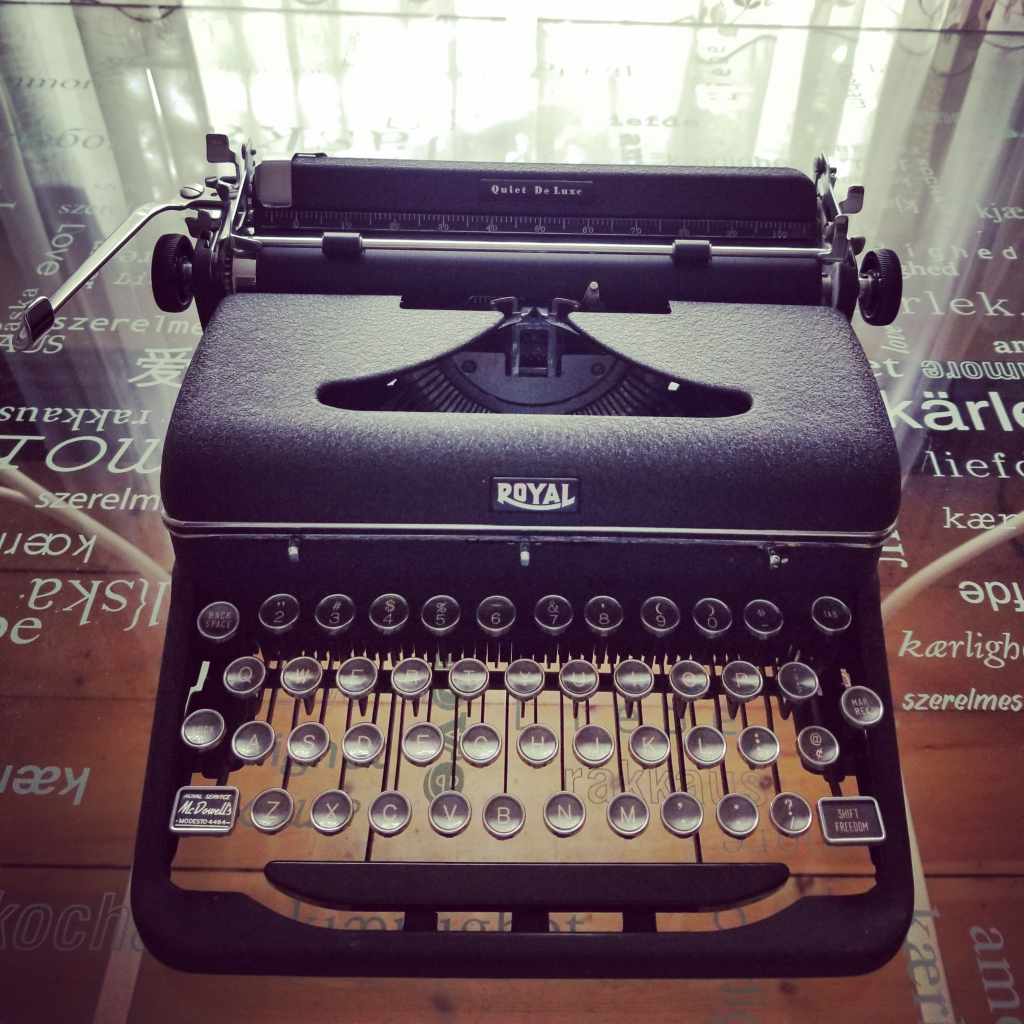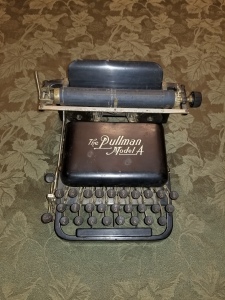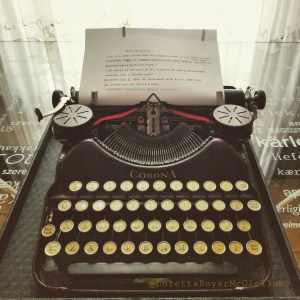
“OLD SCHOOL” INSPIRES! A lifelong writer and creative, the tools to compose are not just essential, but can also be inspirational to the craft. A serendipitous moment of pure clarity brought me to purchase my first manual typewriter. Where modern meets vintage, I searched online for the “writers’ ‘writer” and came across the Royal Quiet De Luxe as the one in multiple articles. I soon found my own machine-with-a-soul in a black crinkle finish 1942 Royal Quiet De Luxe with rare dealer-branded shift key, doubly special as Royal had considerably decreased production during WWII.

This first typewriter purchase unlocked a part of myself that was in great need of that tactile writing experience, the meditative clickity-clack of the keys, the ratchety-ratch of the return lever and the ding! of the bell at the end of a satisfying line of type. I was now a Typewriter Collector. Thirty-two typewriters later (and likely still growing), my collection is more supportive, creative team members of great purpose than just useful tools. I type daily on my typewriters, composing whatever inspiration strikes within, from letters to loved ones, poetry to flash fiction, to short stories, and sometimes a book chapter draft. This also helps me keep a close eye on typewriters in rotation, to know which ‘writer needs what, and when, and those that are fine. Sitting idly on a shelf is not my kind of purposeful collecting.

IT’S PART HISTORIAN, PART TECHNICIAN: I’m not just a Typewriter Collector, however, but also a Typewriter Steward. My collection ranges from 1900s to 1970s in age, of American, European, and Japanese design/manufacture, with almost all in working order and a couple in somewhat working order, soon to be restored to full function in the family workshop. All but three have their cases. I have learned a lot in how to clean and tune up a vintage typewriter, recruiting additional skills as-needed from family members along the way to further my education in the process.
Typewriter collecting has introduced me to a new avenue of creativity: Typewriter Poetry, including Street Poetry. I offer custom poetry for hire, including with writer’s prompt provided by the recipient. It has proven therapeutic for both author and patron. I fully embrace my tagline of “To Create in the Moment is Divine!” There is no deleting or editing, just pure creative flow, so occasionally “Typos Happen,” as I like to say. You can find me and my vintage typewriters at various events year-round, as well as curbside or in the wild, outdoors. My vintage typewriter collection has also provided a wonderful Typewriter Community full of kind and thoughtful people from all around our beautiful world, with online forums where members wax poetic about their favorite typewriters, and share in each others’ journeys and troubleshooting needs. There is a level of courtesy and compassion with typewriter collectors not often seen with other collectible groups.

NO ELECTRICITY REQUIRED: This “revolution” of sorts has brought me back to postal letter writing, a cherished method of communication from the past. There is something not only formal, but permanent, about receiving a manually typed letter. It is also a bit mysterious. To preserve the full quality and effort that goes into the Art of the Typed Letter, all my typewriters are manual. I do not own an electric model. This allows for portability in more rustic, off-grid environments as well, such as on one of my favored campouts.
I appreciate the many fabulous typewriter designs, both aesthetically and mechanistically, previously shelved for decades or for even a century, now put to good use by myself and many other collectors. As a designer and artist, as well as a writer and author, the look of the typer is what initially draws me in, but once I become acquainted with the typewriter’s action and productivity, their personalities fully shine! Please note: choosing a “favorite” typewriter is like choosing a favorite child; it isn’t appropriate or feasible, as each typewriter, at least in my collection, is a purposeful person. Each one is given a name. I love them all dearly.
TYPERWRITER COLLECTION OF LORETTA BOYER McCLELLAN:
Many of the typewriters in my collection were purchased online, with some purchased in-person at estate sales. Their history, of both the typer and previous owner/s is important. I keep full documentation of the purchase and any accompanying documents, user manuals or typewriter ephemera. As I type with each typewriter, I save the writings next to their documentation in a large binder that is soon to be overflowing. The typewriters’ stories are an equally important part of my collection. Where their history isn’t evident, I imagine my writers’ travels prior to landing safely in their new home with their doting guardian. Like a parent showing photos of their cute baby to anyone who is interested, here is my typewriter family:
The first through ninth in my collection, left to right & top to bottom: 1942 Royal Quiet De Luxe (Black crinkle finish with glass key tops and rare dealer-branded shift key), 1961 Royal Tab-o-matic (Gray-blue crinkle finish), 1959 Keller & Knappich Princess 300 (Cream gloss), 1954 Underwood Jewell (Gray-green crinkle finish), 1929 L. C. Smith & Corona Four (Maroon Duco gloss and textured finish),1962 Olympia SM5 (Cream gloss), 1971 Adler Tippa S (Black gloss, plastic body), 1958 Royal Futura 800 (Apple green gloss), and 1968 Olympia SF (Cream and charcoal gray gloss).

The tenth through eighteenth of my Typewriter Collection shown in order of purchase, left to right & top to bottom: red and cream gloss 1967 Royal Custom (the cream portion of the body is plastic), black and chrome satin finish 1959 Olympia Splendid 66, brown crinkle finish with dark and light green keys 1949 Smith-Corona Silent, “teal” (turquoise gloss) 1957 Royal Quiet Deluxe, cocoa brown crinkle finish with dark chocolate keys 1955 Olympia SM-3, robin’s egg-blue satin finish 1966 Smith-Corona Sterling 5AX, gloss black with glass keys 1928 Underwood Model 5, yellow gloss 1979 Brother Citation made in Nagoya Japan, and a gray satin finish 1965 Smith-Corona Classic 12 with wider/landscape carriage. They each bring me joy!

Nineteenth through twenty-seventh of my typewriter collection in order of purchase, from left to right and top to bottom: gray and cream satin finish 1966 Smith-Corona Galaxie II, black gloss 1934 L.C. Smith & Corona Silent flat top, cream gloss 1962 Olympia SM5 (second of this same model and year), turquoise gloss 1970s Underwood 315 (made in Spain of Olivetti design after Underwood-Olivetti merger and same keys as Olivetti Valentine; plastic body), green satin finish 1960s/70s Smith-Corona Galaxie Deluxe with cream plastic accent, cream gloss 1965 Olympia SM9, teal crinkle finish and pale gray gloss 1950s Underwood Ace, navy gloss 1970s Adler J5 (plastic body), and 1928 green crackle/lizard lacquer Royal Portable “Model P” (with partial “Anderson Typewriter Company” dealer decal; dealer company founded in 1912 in Pasadena, CA, they were the West Coast Royal dealer and are still in business, still in Pasadena, now operating as Anderson Business Technology. Being a 1928 model and with Anderson a major Royal dealer near Hollywood, it’s possible my green Royal Model P is one of the hundreds of Model Ps dropped by parachute from airplanes to typewriter dealers across the U.S. in 1928 in a major publicity stunt).

Twenty-eighth through thirty-first in my collection, from left to right, top to bottom: 1971 to 1974 orange two-tone satin finish Chevron model made by Messa in Spain for Sears (metal ribbon cover but plastic remaining body), black and gray crinkle finish 1948 Henry Dreyfuss-designed Royal Quiet Deluxe with tombstone keys, blue and cream gloss 1967 Royal Aristocrat in cursive type (the cream part of the body is plastic), and a black gloss 1937 Remington 5 Streamliner with “PAR” key, known as the Victor overseas. Last but not least is my thirty-second typewriter, a black gloss 1909-1915 American Typewriter Company Pullman Model A “upstrike” manufactured for Sears & Roebuck. The photo is shown above in the third paragraph.
Typewriter collecting has become a most meaningful purpose, where use is offered once again to once-slumbering machines. Writing has become the recipient of that deeper meaning as well, as the writer-author too has been awakened!

Words and images ©2022 Loretta McClellan; all rights reserved.

A writer, poet and journalist, Loretta Boyer McClellan is the author of six books, including the Misthaven of Maine Series: Misthaven of Maine and Misthaven of Maine: Journey to Beyond; Dodging Raindrops: Poems and Prose of Beauty, Peace and Healing; The Nature of BEing: A Healing Journey; The Little Book of Everlasting Joy: 16 Pieces of Wisdom for Our Time; and Meet Me On the Other Side of Wonder: Selected Poems. Loretta’s books are available on Amazon or wherever books are sold. For Author Events, Typewriter Poetry events, writing services or media contact, visit the Contact page.